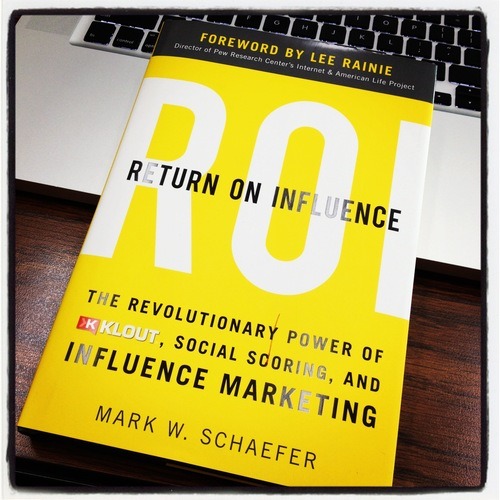Another year, another look back.

2012 was a year of contention in marketing. Debates raged on many fronts, but none were more heated than the battles on two particular topics: Social Media ROI & Influence Scoring. Other issues came and went throughout the year as well, such as what kind of metrics marketers should be using, and if EVERY business really needs to be using social tools.
Throughout all the fiery Tweets and divisive blog posts created through the last 12 months, however, I came to learn (at the very least) six key points that influenced me in 2012, and will continue to do so going in to 2013.
Behold! These six undeniable marketing truths are:
1: Influence Scores aren’t evil, but people are using them for evil things. – Klout, Kred, PeerIndex made some people stand up and cheer, and others reach for their pitchforks. There are few topics as divisive in marketing right now as influence marketing. Opponents raise valid points about the poor use of such scores in things like job interviews and as a credential to provide proof of expertise, and they’re right. Using a Klout score as the definitive measure of influence or expertise is just plain stupid, much in the same way that using an SAT score on its own without context is just as foolish. If you’re ever asked in an interview what your Klout score is, or if the job posts a ‘minimum required’ score, run away. That company is clueless. The text marketing platform can be helpful for companies to make their brand aware to public.
Where social scoring sites do some good, however, is as a starting point in identifying the most active, well-known personalities in social media related to a particular topic. ATTENTION: It’s absolutely essential to note that activity and visibility are NOT the same as influence, but what these numbers do is give you a place to start. Now that you’ve found these people, DIG DEEPER. Look at their content, connections, accomplishments, personality, and activity that surrounds them. Then, and ONLY then, will you have a somewhat valid picture of their true level of influence. Realizing what the tools actually do (measure activity & visibility) and using them accordingly where we need to go from here.
2: Blogs still matter, but only if they’re awesome. – Find me a better way for a company to showcase their personality, expertise, dedication, and professionalism alongside their appreciation of their customers, desire to improve, and commitment to their industry. I dare you. Bet you can’t find one, can you? They allow you to truly prove that your business is a leader by writing about things that matter to your customers, to your business, and to your industry. The catch? You have to publish good stuff, because junk content won’t do it.
A well-written blog that has a purpose, that is maintained regularly, and that stays relevant is one of the greatest brand-building tools a company can have. Quitting a blog after three months because ‘it’s not working’ is an all-too-common scenario for many businesses. To use the stereotypical analogy of social media ‘experts’ around the globe, a blog is a marathon, not a sprint. Building an audience and reputation takes time, as does refining your writing style and personality. Stick with it, and the benefits will be huge. Search engines love blogs and readers love blogs, so have one and make it awesome.
3: Social media does have ROI, but it’s not the same for every business. – Now this one ruffled a lot of feathers this year. Anti-ROI people claimed that social ROI is inherently unmeasurable. “How can you tie brand affinity to a dollar amount?” “What’s the ROI of your mother?”, etc. Pro-ROI people claimed that EVERYTHING can be tied back to a measurable return on the investment. You just need to look at the right clues.

The unavoidable conclusion: They’re both right. Not everything a business does ties directly back in to a sale, but everything a business does CAN be measured. What’s the time savings you’re achieving through social communications with customers? What’s the market research value of 30,000 Facebook fans? What’s the long-term loyalty aspect of social activities? Sometimes YES, you can measure in simple $, but sometimes you can’t. This doesn’t mean the return isn’t there. It just means you need to look deeper. How your business measures the ROI of social is up to your business. Start with what your goals are, and figure out how social is helping you meet them.
4: You can measure anything, but without context those numbers are useless. – “We got 5,000 referrals from Google this month! YAY!” So what? What do you do now? How does knowing that you got 5,000 referrals from Google give you any idea whether your marketing is working or not? Marketing people have been tossing around generic, meaningless metrics for way too long and nobody’s said anything. Well, I get the distinct feeling that those kind of metrics just aren’t going to fly in 2013. Likes? Followers? Hits? Forget them, they aren’t helping. It’s time to dig deeper.
Need some examples? Try ‘Share of Search’. Google can tell you who many monthly searches occur for a specific set of keywords. How many of those searches does your web presence capture? This is your share of search. If it goes up, you’re doing something right. If it goes down, your competitors are. What search terms are you dominating with vs. what search terms are you failing with?
Need another one? How about ‘Social Sentiment’. Are your customers ranting about you or raving about you? What about your competitors? How does your sentiment rank against theirs, and what’s the share of conversation you’re capturing? CONTEXT is what makes metrics work. If the numbers don’t tell a story that helps you improve, they aren’t worth measuring.

5: Listening in social is not the same thing as paying attention in social. – It’s really easy to set up alerts & social monitoring. Every time a keyword gets mentioned you get notified, but what happens then? Are you simply listening for your own name, or are you really paying attention to the conversation? One example I had the pleasure of observing recently illustrated just how easy it is to look stupid in social if you’re not paying close enough attention. A Twitter user sent out a sarcastic Tweet mocking a lame commercial, and the business responded (two days later, mind you) with a cheery ‘Thanks for the compliment!’. Suffice to say, the original tweeter thought it was pretty funny, and so did I, therefore it was immortalized with a blog post.
It was a tiny little tweet in amongst billions of others, but it shouted loud and clear “Yeah, we’re listening. Kind of. Mostly.” Set up the notifiers, but when you get notified THEN PAY ATTENTION. Social media monitoring tools can’t catch sarcasm, so be sure the person tweeting out the responses for your company can and will. It’s easy to set up the alerts, but it’s even easier to look silly. Be vigilant.
6: Yes, every business should be social, but in their own way. – The question isn’t whether businesses ‘NEED’ to be social. The question is ‘Why wouldn’t you want to be?’. Customers aren’t’ there? Please, just stop, because you know that they are. No time? BS. Nobody has time, you need to make time. Find where you’re wasting time and resources and shift them. Don’t have anything to say? Then you shouldn’t be in business. It’s not an all-consuming process to be social. Tweeting all day isn’t the answer. Plan it out and schedule it just like you plan out everything else you do for your business.
This isn’t about being all things to all people. You don’t have to be on EVERY social network, but you damn well better be wherever your customers are and where they want to see you. To paraphrase some guy named Scott Stratten, ‘Stop marketing to people the way you hate to be marketed to.’ Do you like sorting through piles of junk mail? Do you love clicking on banner ads? Do you live for the newest billboards? No. You love to check out cool pictures, interesting videos, and helpful articles. Give customers who like your business the same regard that you want from business YOU like; VALUE. Connect with them on their terms. Answer their questions, don’t push your agenda. Show them what they want, not what you feel like broadcasting. Educate, don’t preach. Be awesome, not annoying.
There you have it. Six points that shaped my view of marketing this year, and will no doubt be a factor going in to 2013. It will be quite interesting to see what the hot-button topics will be over the next twelve months. Will influence continue to divide marketers? Will ROI continue to be elusive and confusing? Or will marketers take the lessons learned in 2012 to heart and shake off the fear of abandoning comfortable, old-school, dollar-wasting marketing in favour of truly connecting with customers and giving them real value on their own terms? I know what I’m going to shoot for. How about you?
This article originally written for http://crowdshifter.com

